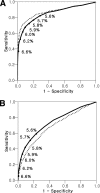Hemoglobin A1c as a diagnostic tool for diabetes screening and new-onset diabetes prediction: a 6-year community-based prospective study
- PMID: 21335372
- PMCID: PMC3064055
- DOI: 10.2337/dc10-0644
Hemoglobin A1c as a diagnostic tool for diabetes screening and new-onset diabetes prediction: a 6-year community-based prospective study
Abstract
Objective: Various cutoff levels of hemoglobin A(1c) (A1C) have been suggested to screen for diabetes, although more consensus about the best level, especially for different ethnicities, is required. We evaluated the usefulness of A1C levels when screening for undiagnosed diabetes and as a predictor of 6-year incident diabetes in a prospective, population-based cohort study.
Research design and methods: A total 10,038 participants were recruited from the Ansung-Ansan cohort study. All subjects underwent a 75-g oral glucose tolerance test at baseline and at each biennial follow-up. Excluding subjects with a previous history of diabetes (n = 572), the receiver operating characteristic curve was used to evaluate the diagnostic accuracy of the A1C cutoff. The Cox proportional hazards model was used to predict diabetes at 6 years.
Results: At baseline, 635 participants (6.8%) had previously undiagnosed diabetes. An A1C cutoff of 5.9% produced the highest sum of sensitivity (68%) and specificity (91%). At 6 years, 895 (10.2%) subjects had developed incident diabetes. An A1C cutoff of 5.6% had the highest sum of sensitivity (59%) and specificity (77%) for the identification of subsequent 6-year incident diabetes. After multivariate adjustment, men with baseline A1C ≥5.6% had a 2.4-fold increased risk and women had a 3.1-fold increased risk of new-onset diabetes.
Conclusions: A1C is an effective and convenient method for diabetes screening. An A1C cutoff of 5.9% may identify subjects with undiagnosed diabetes. Individuals with A1C ≥5.6% have an increased risk for future diabetes.
Figures
References
-
- Chan JC, Malik V, Jia W, et al. Diabetes in Asia: epidemiology, risk factors, and pathophysiology. JAMA 2009;301:2129–2140 - PubMed
-
- Harris MI, Klein R, Welborn TA, Knuiman MW. Onset of NIDDM occurs at least 4-7 yr before clinical diagnosis. Diabetes Care 1992;15:815–819 - PubMed
-
- UK Prospective Diabetes Study Group Effect of intensive blood-glucose control with metformin on complications in overweight patients with type 2 diabetes (UKPDS 34). Lancet 1998;352:854–865 - PubMed
Publication types
MeSH terms
Substances
LinkOut - more resources
Full Text Sources
Medical


